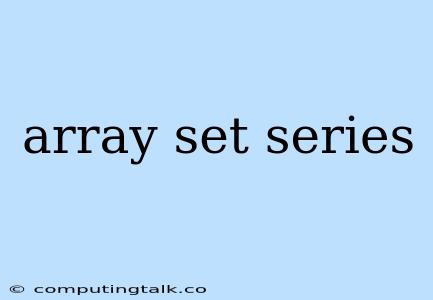Arrays, sets, and series are fundamental data structures in programming, each serving distinct purposes. Understanding their differences and applications is crucial for efficient and organized data management.
What is an Array?
An array is a collection of elements of the same data type stored in contiguous memory locations. Each element is accessed using an index, starting from 0 for the first element.
Key Characteristics of Arrays:
- Ordered: Elements in an array are stored in a specific sequence, allowing you to access them based on their position.
- Fixed Size: Once an array is created, its size is fixed. You cannot dynamically add or remove elements without resizing the array.
- Direct Access: Elements in an array can be accessed directly using their index.
Examples of Array Usage:
- Storing a list of student names.
- Representing a grid of pixels in an image.
- Managing a queue of tasks in a system.
What is a Set?
A set is an unordered collection of unique elements. Unlike arrays, sets do not allow duplicates.
Key Characteristics of Sets:
- Unordered: Elements in a set are not stored in a specific order.
- Unique: Sets do not allow duplicate elements. Each element must be unique.
- Membership Checking: You can efficiently check if an element exists in a set using the "in" operator.
Examples of Set Usage:
- Storing a list of unique user IDs.
- Tracking the unique words in a document.
- Identifying distinct values in a dataset.
What is a Series?
A series, in the context of programming, often refers to a sequence of data points, usually associated with a time dimension. It is often used for time series analysis.
Key Characteristics of Series:
- Ordered: Data points are arranged in a specific sequence, usually based on time.
- Time-Based: Data points are typically associated with specific timestamps or intervals.
- Trend Analysis: Series data is often used to identify trends, patterns, and anomalies over time.
Examples of Series Usage:
- Tracking stock prices over a period.
- Analyzing website traffic data over time.
- Monitoring sensor readings at regular intervals.
Choosing the Right Data Structure:
The choice between arrays, sets, and series depends on the specific requirements of your program.
- Use arrays when:
- You need a fixed-size collection of elements.
- You need to access elements by their index.
- Order is important for your data.
- Use sets when:
- You need a collection of unique elements.
- Order is not important.
- You need to efficiently check for membership.
- Use series when:
- You need to analyze data over time.
- Data points are associated with specific timestamps.
Conclusion
Arrays, sets, and series are powerful data structures that provide different ways to organize and manipulate data. Understanding their unique characteristics and applications is essential for efficient programming. Choosing the right data structure for your specific needs can significantly improve the performance and clarity of your code.
